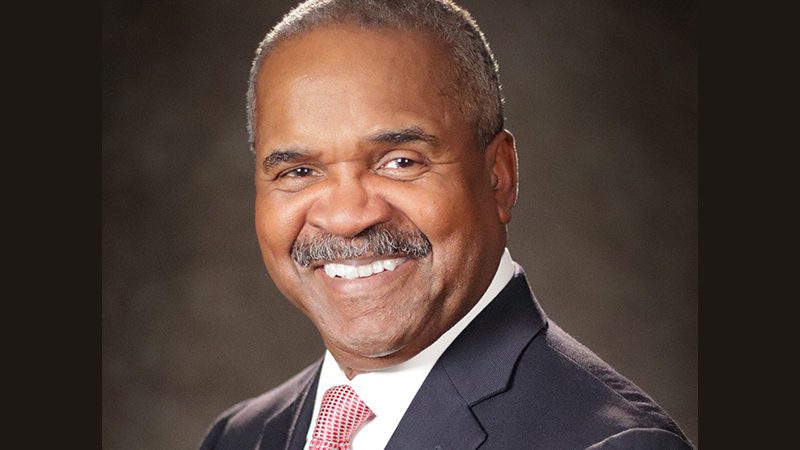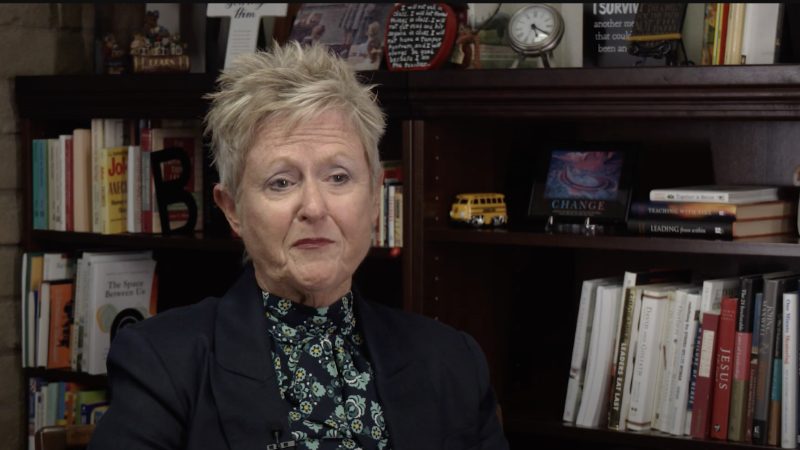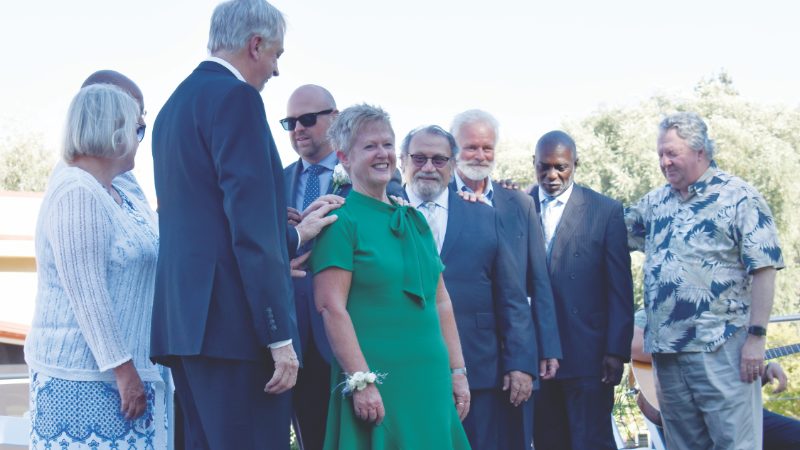I recently flew over much of the state of California and was awed by the bright green hills and the snow lingering in the mountains this late in the year. Throughout our union territory, it has been a spring of extravagantly bright flowers, lush landscapes, and late blossoming trees as the rains just kept coming. Such vibrant beauty!
Mere months ago, we were in a severe drought all over the Pacific Union, resulting in water rationing, dead lawns, and extreme fire danger. What a difference the rains and snow have made, with reservoirs filling up and some of us wondering when the rain would finally stop and the sun emerge.
We had been living in a parched and weary land for so long we had given up hope of seeing it come to life again.
We had been living in a parched and weary land for so long we had given up hope of seeing it come to life again.

I am reminded of the prophet Ezekiel as I look at this new life springing up in what was once a cracked, brown, and dead landscape. Do you remember his description of the valley of dead, dry, and parched bones in Ezekiel 37? It is a jarring image of lifelessness. After showing this scene to Ezekiel in a vision, God asks him if these bones can live. God tells Ezekiel that these bones represent His people of Israel and says, “Listen to what they’re saying: ‘Our bones are dried up, our hope is gone, there’s nothing left of us’” (Ezekiel 37:11, The Message).
Living in exile, God’s people were weary and spent. They were not allowing God to refresh, revive, and renew them through His Spirit. Instead, they were discouraged, disillusioned, and downcast. God used Ezekiel as one of His final prophetic voices, pleading with the people to come back to Him and receive lifegiving breath.
God was not giving up! As Ezekiel walked among the bones in his vision, God asked Ezekiel if the bones could live, to which Ezekiel replied, “Only you know, God” (verse 3).
God commanded Ezekiel to prophesy. He records that, as he was prophesying, “there was a noise, and suddenly a rattling; and the bones came together, bone to bone. Indeed, as I looked, the sinews and the flesh came upon them, and the skin covered them over; but there was no breath in them” (Ezekiel 37:7-8, NKJV).
God commanded Ezekiel to speak again; this time he was to prophesy to the breath. As he did so, “breath came into them, and they lived, and stood upon their feet, an exceedingly great army” (Ezekiel 37:10, NKJV).
God reminds His people through these graphic images that He will breathe the freshness of His Spirit into them so they may live and know that He is their God, always and forever.
He is our Living Water, our Stream in the Desert, our Deep Well, our Giver of Life.

Ellen White assures us, “Our life is to be bound up with the life of Christ; we are to draw constantly from Him, partaking of Him, the living Bread that came down from heaven, drawing from a fountain ever fresh, ever giving forth its abundant treasures. If we keep the Lord ever before us, allowing our hearts to go out in thanksgiving and praise to Him, we shall have a continual freshness in our religious life” (Christ’s Object Lessons, p. 129).
Is your soul a bit parched and weary? Are you on the run and weighed down with responsibilities and never-ending to-do lists that leave you longing for unhurried time and space with God? Do these words ring true with you, “As the deer pants for streams of water, so my soul pants for you, my God” (Psalm 42:1, NIV)?
Look to the green hills. Look to the land that is refreshed around you. Press the pause button for a bit and allow the Spirit of God to breathe life into you.
After all, that is what God does. He is our Living Water, our Stream in the Desert, our Deep Well, our Giver of Life. Drink deeply, breathe in, and flourish today.
_____________________________
Sandra E. Roberts is the executive secretary and the ministerial director of the Pacific Union Conference.
«Bebiendo de una fuente siempre fresca»
Recientemente volé sobre gran parte del estado de California y me impresionaron las lujuriosas verdes colinas y la nieve que persistía en las montañas a principios de la primavera. En todo nuestro territorio de la unión, ha sido una primavera de flores extravagantemente hermosas, paisajes exuberantes y árboles de floración tardía a medida que las lluvias seguían cayendo. ¡Qué belleza tan vibrante!
Hace apenas unos meses estábamos en una terrible sequía en toda la Pacific Union, lo que dio lugar a racionamiento de agua, césped muerto y extremo peligro de incendios. Las lluvias y la nieve han producido un cambio radical, con diques llenos al tope y algunos nos preguntábamos cuándo pararía finalmente de llover y volvería a brillar el sol.
Habíamos estado viviendo en una tierra reseca y cansada durante tanto tiempo que habíamos perdido la esperanza de verla volver a la vida.
Habíamos estado viviendo en una tierra reseca y cansada durante tanto tiempo que habíamos perdido la esperanza de verla volver a la vida.

Me recuerda al profeta Ezequiel cuando miró esa nueva vida que brotaba en lo que una vez fue un paisaje agrietado, reseco y muerto. ¿Recuerdas su descripción del valle de huesos muertos y secos en Ezequiel 37? Es una imagen discordante de la falta de vida. Después de mostrarle esa escena a Ezequiel en una visión, Dios le preguntó si esos huesos podrían tener vida. Dios le dijo a Ezequiel que esos huesos representaban a Israel, su pueblo, y le dijo: «Escucha lo que dicen: “Nuestros huesos se han secado, nuestra esperanza se ha ido, no queda nada de nosotros”» (Ezequiel 37:11, El Mensaje).
Viviendo en el exilio, el pueblo de Dios estaba cansado y agotado. No estaba permitiendo que Dios los refrescase, reviviese y renovase a través de su Espíritu. Al contrario, estaba desanimado, desilusionado y abatido. Dios usó a Ezequiel como una de sus últimas voces proféticas, suplicando a la gente que volviese al Señor y recibiese aliento vivificante.
¡Dios no se estaba dando por vencido! Mientras Ezequiel caminaba entre los huesos en su visión, Dios le preguntó si esos huesos podrían vivir, a lo cual Ezequiel respondió: «Sólo tú lo sabes, Señor» (versículo 3).
Dios le ordenó a Ezequiel que profetizase. Nos cuenta que, mientras profetizaba, «oí un ruido: era un terremoto, y los huesos comenzaron a juntarse unos con otros. Y vi que sobre ellos aparecían tendones y carne, y que se cubrían de piel. Pero no tenían aliento de vida» (Ezequiel 37:7-8).
Dios le ordenó que hablase de nuevo; esta vez debía profetizar al aliento. Al hacerlo, «el aliento entró en ellos, y vivieron, y se pusieron de pie, un ejército extremadamente grande» (Ezequiel 37:10).
Dios le recuerda a su pueblo a través de esas gráficas imágenes que él soplará el frescor de su Espíritu en ellos para que puedan vivir y sepan que él es su Dios, para siempre jamás.
Él es nuestra Agua Viva, nuestra fuente en el desierto, nuestro pozo profundo, nuestro dador de vida.

Ellen White nos asegura: «Nuestra vida ha de estar unida con la de Cristo; hemos de recibir constantemente de él, participando de él, el pan vivo que descendió del cielo, bebiendo de una fuente siempre fresca, que siempre ofrece sus abundantes tesoros. Si mantenemos al Señor constantemente delante de nosotros, permitiendo que nuestros corazones expresen el agradecimiento y la alabanza a él debidos, tendremos una frescura perdurable en nuestra vida religiosa» (Palabras de vida del Gran Maestro, p. 100).
¿Está tu alma un poco reseca y cansada? ¿Estás huyendo y agobiado por las interminables responsabilidades y listas de tareas pendientes que te dejan anhelando tiempo y espacio sin prisas para estar con Dios? ¿Hacen eco en ti estas palabras: «Cual ciervo jadeante en busca del agua, así te busca, oh Dios, todo mi ser» (Salmo 42:1, NVI)?
Contempla las verdes colinas. Contempla como la tierra se regenera a tu alrededor. Presiona el botón de pausa por un momento y permite que el Espíritu de Dios te dé vida.
Después de todo, eso es lo que Dios hace. Él es nuestra Agua Viva, nuestra fuente en el desierto, nuestro pozo profundo, nuestro dador de vida. Bebe profundamente, inhala y florece hoy.
_____________________________
Sandra E. Roberts es la secretaria ejecutiva y directora ministerial de la Pacific Union Conference.






